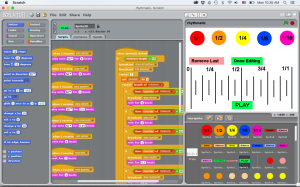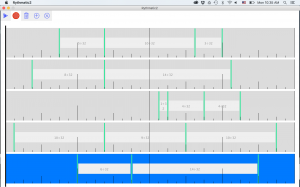Rhythmatic
Nov 17th, 2015 by Ron Eglash
Product Evaluation
The goal established by our team is to teach fifth graders fractions by utilizing their intuition and music. The way we decided to do this is by creating a program and using musical notation, which already denotes fractions of a measure, to allow the students to see and hear the addition of fractions on a timeline. The program is used in conjunction with human help, as a teacher is still needed to present information. We then came up with an informal list of specifications, which can be broken up into technical and user specifications. This list can be seen below:
Scratch Program
Processing Program
Technical Specifications
- leverage user’s pre-existing interest in music and transfer to academics
- teach information (in this case, fractions/ratios) in a fun/understandable way
- hits recorded from a conductive input device are registered no matter how the input device is used–tapped or banged on, etc – registers hits with a minimum temporal spacing of ~25ms and minimum applied force required to make an audible sound
- easy to set up/take down and move – under 10 pounds
- visual playback of the recording matches input (no perceptible lag)
User Specifications
- improve user’s understanding of subject taught through device
- easy to use/intuitive interface – instructions for use only need to be given 1 time
Testing
Given this list, it is fairly easy to verify the product according to the technical specifications: many of the specifications can be easily tested. The recording and playback of hits can simply be tested on the program and timed for inaccuracy, and a user may test different forces and any effects on the device. It may also be weighed and timed for set up/take down.
Product validation is more difficult to test, because it needs to assess whether the user specifications described what the user needs. For this, more in-depth testing is required. Ideally, we would have two groups: a control group and intervention group. The control group would use the same software, but with no music, which would be a software program that adds fractions together to make one. Therefore, the intervention group would use our music program. These groups, in order to yield statistically significant results, would need to be one class of 25-30 students each. Each of these groups would take a pre-test and post-test (after using the program) and the before/after scores would individually be compared, taking note that a pair of before/after scores were associated with one individual, but storing no personal information for the particular individual. This data would be used in a paired T test in order to determine the statistical significance. Other, more abstract specifications can be evaluated by observing the subjects during lessons and testing periods.
Challenges
In doing this study, there are several factors that are worth mentioning. The first of these is ethics, which is highly important for educators and those involved in the law. With this study, there is no problem with educational opportunities, as each child will be exposed to the same content, and the variable is the way in which the content is presented. However, some students know more or less about music than others, and the challenge there is making sure that each student in the intervention group is equally included and not simply getting bored and wandering away—doing so would negate any effects of our program. On another note, it may actually be interesting to look at how prior knowledge of music affects the test scores. If the number of children who have a background of music are approximately equal across groups and said individuals are known, the challenge of history can be eliminated or at least mitigated.
The nature of software does not allow for many instrumental challenges to internal validity, assuming software stays the same, because nothing of the instrumental sort is able to change. However, a challenge to internal validity may also be the person or style of teaching that accompanies the software, so in studying this, the lesson taught should be by the same teacher for each separate group such that the control and intervention groups have the same experience, with different programs.
Lastly, experimental mortality can be reduced by having students who are absent for either a test or the lesson complete the activity upon their return without discussing with other students. Therefore, each student is receiving the same educational opportunity, and the only difference for absentees is the lack of other students present during an activity they are making up.
As a final note, it may be interesting to test the effect when the music program is used; it may be used to initially teach a lesson and then reinforced with a non-musical fraction lesson, or students may be given a non-musical lesson and then relate the fractions to music afterward. This may be done after an initial round of testing the effects of the intervention, then having the control group and intervention group switch, such that the control group receives the intervention and the intervention group receives a lesson with no music next. The same pre/post-testing and paired T test applies.
The user specifications can be tested effectively using the previously described method. The paired T test describes whether the addition of music to a fraction lesson is helpful for learning. In the process, it can be easily determined whether the interface is intuitive or usable by simply observing the subjects and their reactions to it—confusion, the amount of time it takes to finish an activity, or positive or negative exclamations or body language are all indicators of how usable the program is. Surveying the students and asking them their thoughts is another way of doing this, however this method is easily skewed by the social dynamic of the group (ie. An alpha male states that he hated it, and the rest of the group subsequently agrees). The repetition of the study with the groups switching answers an additional question of whether a lesson appealing to students’ interests more is more effective (if at all!) before or after learning the academic material dry.
This page has the following sub pages.

